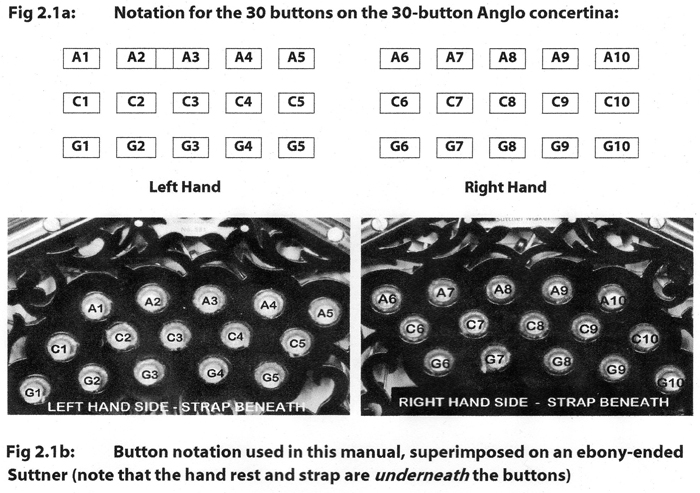Here are some sample pages/content
from THE CONCERTINA DIARIES. This should give you a good idea of what
you can expect, when you buy this new manual.
First, let us show you the simple concertina button notation used throughout the manual. It's really easy (the illustration below is from Chapter Two):

The inside row of buttons - the row nearest to the finger-strap - is known as the "G row". The middle row is the "C row". The outside row,
because it consists mainly of sharps or flats which are used as
'accidentals' in tunes (though the important C sharp notes are found
there too!), is referred to as the "A row" ("A" is NOT to be confused
with the KEY of A major, which is a different matter altogether!).
Buttons on the left-hand side are numbered from 1 to 5, and on the
right-hand side from 6 to 10.
The only additional thing you need to know is whether the note is to be found by pushing or pulling. The notation makes it easy: a 'push' is underlined, and a 'pull' isn't. It's that easy. A very short while using this notation will make it second nature to you.
First... while
writing this manual, I thought about it a great deal. This meant that I
dreamt about it. One of my dreams actually led me to write a short
insert which points out some key differences between the Anglo
concertina and most other musical instruments. Read about these in the
downloadable page below:
The inside front cover contains charts which you will find yourself referring to time and again. These are charts showing the positioning of the notes on Wheatstone and Jeffries type layouts, and these are colour-coded to show you how you can find the same note by using different buttons. Check out the downloadable file below:
Below are some sample tunes - as you'll see, written in standard musical notation, the kind of ABC notation most commonly used in Ireland, and the concertina notation described on this page, above. Note that the first 15 tunes - the "Core Tunes" - have a separate page with Notes/Learning Points.
The first couple of tunes are chosen just to get you used to using the concertina. The first two tunes employ a limited number of buttons all from a single row. Tune 1, the well known Newmarket Polka, can easily be played using buttons from the middle (C) row only.





